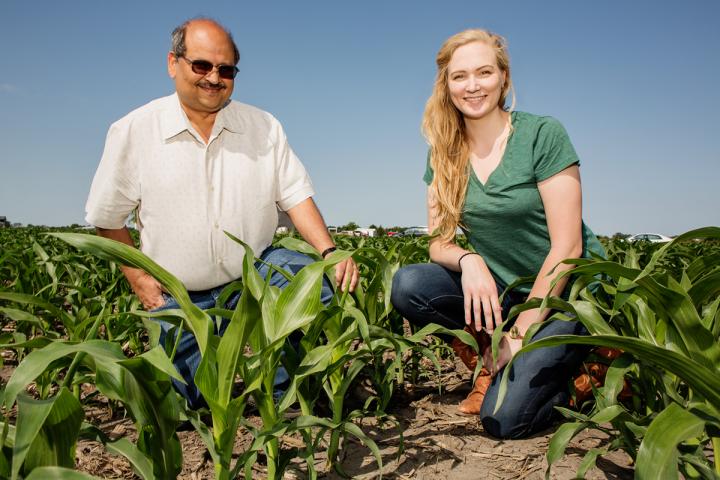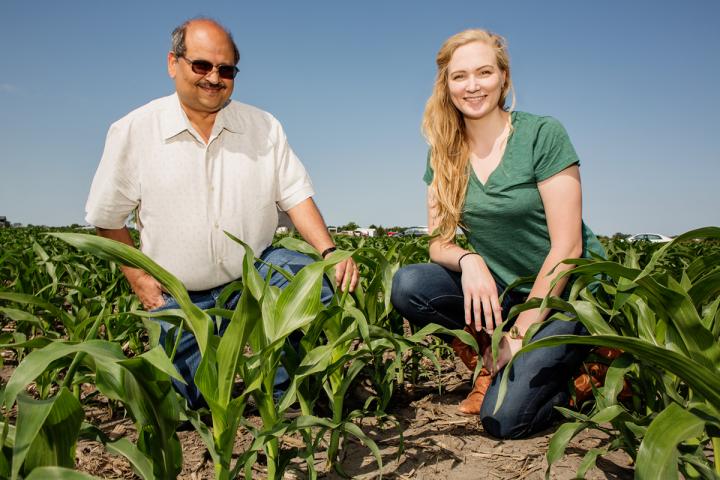
Credit: Photo by: L. Brian Stauffer
Corn is grown not only for food, it is also an important renewable energy source. Renewable biofuels can come with hidden economic and environmental issues, and the question of whether corn is better utilized as food or as a biofuel has persisted since ethanol came into use. For the first time, researchers at the University of Illinois have quantified and compared these issues in terms of economics of the entire production system to determine if the benefits of biofuel corn outweigh the costs.
Civil and environmental engineering professor Praveen Kumar and graduate student Meredith Richardson published their findings in the journal Earth's Future.
As part of a National Science Foundation project that is studying the environmental impact of agriculture in the U.S., the Illinois group introduced a comprehensive view of the agricultural system, called critical zone services, to analyze crops' impacts on the environment in monetary terms.
"The critical zone is the permeable layer of the landscape near the surface that stretches from the top of the vegetation down to the groundwater," Kumar said. "The human energy and resource input involved in agriculture production alters the composition of the critical zone, which we are able to convert into a social cost."
To compare the energy efficiency and environmental impacts of corn production and processing for food and for biofuel, the researchers inventoried the resources required for corn production and processing, then determined the economic and environmental impact of using these resources – all defined in terms of energy available and expended, and normalized to cost in U.S. dollars.
"There are a lot of abstract concepts to contend with when discussing human-induced effects in the critical zone in agricultural areas," Richardson said. "We want to present it in a way that will show the equivalent dollar value of the human energy expended in agricultural production and how much we gain when corn is used as food versus biofuel."
Kumar and Richardson accounted for numerous factors in their analysis, including assessing the energy required to prepare and maintain the landscape for agricultural production for corn and its conversion to biofuel. Then, they quantified the environmental benefits and impacts in terms of critical zone services, representing the effects on the atmosphere, water quality and corn's societal value, both as food and fuel.
In monetary terms, their results show that the net social and economic worth of food corn production in the U.S. is $1,492 per hectare, versus a $10 per hectare loss for biofuel corn production.
"One of the key factors lies in the soil," Richardson said. The assessment considered both short-term and long-term effects, such as nutrients and carbon storage in the soil.
"We found that most of the environmental impacts came from soil nutrient fluxes. Soil's role is often overlooked in this type of assessment, and viewing the landscape as a critical zone forces us to include that," Richardson said.
"Using corn as a fuel source seems to be an easy path to renewable energy," said Richard Yuretich, the NSF program director for Critical Zone Observatories. "However, this research shows that the environmental costs are much greater, and the benefits fewer, than using corn for food."
###
The National Science Foundation supported this research through the Grants for Intensively Managed Landscapes Critical Zone Observatory.
Editor's notes:
To reach Praveen Kumar, call 217-333-4688; [email protected].
The paper "Critical zone services as environmental assessment criteria in intensively managed landscapes" is available online and from the U. of I. News Bureau.
Media Contact
Lois E Yoksoulian
[email protected]
630-696-6715
@NewsAtIllinois
http://www.illinois.edu
############
Story Source: Materials provided by Scienmag





